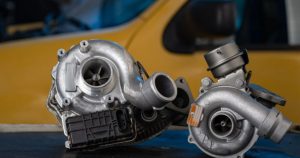Turbochargers have revolutionized how internal combustion engines perform, providing drivers with enhanced power, better efficiency, and improved overall driving experience. While once limited to high-performance sports cars and heavy-duty vehicles, modern turbochargers are now found in everything from small sedans to hybrid SUVs.
In this article, we’ll explain how turbochargers work, what benefits they bring, the importance of proper maintenance, and common problems you can prevent. Understanding your turbo is key to unlocking your engine’s full potential.
What Is a Turbocharger?

A turbocharger (or “turbo”) is a forced induction system that increases an engine’s efficiency and power output by forcing more air into the combustion chamber. More air means more oxygen, which allows the engine to burn more fuel and produce more power — all without increasing engine size.
How It Works:
-
Exhaust gases from the engine spin a turbine.
-
The turbine shaft connects to a compressor wheel.
-
The compressor pulls in and compresses ambient air.
-
Compressed air is fed into the engine’s intake manifold.
-
More air = more power per engine stroke.
Turbocharged vs. Naturally Aspirated Engines
| Feature | Naturally Aspirated | Turbocharged |
|---|---|---|
| Air Intake Method | Relies on atmospheric pressure | Uses exhaust to force more air |
| Power Output | Lower | Higher for same displacement |
| Fuel Efficiency | Lower | Potentially higher |
| Emissions | More CO₂ per power unit | Cleaner due to better combustion |
| Engine Size | Often larger | Can be smaller/lighter |
Key Benefits of a Turbocharger
1. Increased Horsepower and Torque
Turbochargers can increase an engine’s power output by up to 50% or more. This means smaller engines can deliver performance similar to larger engines without added weight or bulk.
2. Better Fuel Economy
Engines with smaller displacement but equipped with turbos consume less fuel under normal driving, especially at lower RPMs. This results in a balance of performance and economy.
3. Reduced Emissions
Turbocharged engines can run leaner — that is, they use more air and less fuel. This cleaner combustion reduces carbon emissions and helps manufacturers meet stricter environmental standards.
4. Improved Altitude Performance
At higher altitudes, naturally aspirated engines struggle due to thinner air. Turbos mitigate this by forcing air in regardless of ambient pressure.
Common Types of Turbochargers
| Turbo Type | Description |
|---|---|
| Single Turbo | Standard setup with one turbine and compressor |
| Twin Turbo | Two turbos working in sequence or parallel (often used in V6/V8 engines) |
| Variable Geometry Turbo (VGT) | Adjusts vane angles for optimal airflow at different speeds |
| Electric Turbo | Uses electric motor to reduce lag and improve response |
Signs of a Failing Turbocharger
Ignoring turbo issues can lead to expensive repairs or even engine failure. Watch for these warning signs:
-
Loss of power — Noticeable drop in acceleration and top-end performance.
-
Excessive exhaust smoke — Blue or black smoke could mean oil leakage or improper fuel burning.
-
Whining noise — A high-pitched whine could indicate bearing failure or air leaks.
-
Check engine light — ECU detects irregularities in boost pressure or airflow.
-
Oil consumption — Leaking turbo seals may cause faster oil usage.
Turbocharger Maintenance Tips
Turbochargers are robust but require some special care to ensure long life and optimal performance.
Maintenance Checklist
| Task | Frequency |
|---|---|
| Use high-quality engine oil | Every oil change (5,000–10,000 km) |
| Change air filters regularly | Every 15,000–20,000 km |
| Allow engine to cool down | Let turbo idle for 30-60 sec before shutdown after hard driving |
| Avoid aggressive driving when cold | Especially in first 5–10 minutes of engine start |
| Inspect turbo hoses and intercooler | Every 20,000–30,000 km |
Additional Tips:
-
Always follow manufacturer-recommended oil viscosity and coolant levels.
-
Consider synthetic oils with high-temperature tolerance for turbocharged engines.
-
Avoid sudden throttle lift-off from high RPMs — it can shock the system.
Turbo Lag vs. Boost — What’s the Difference?
-
Turbo Lag: Delay between throttle input and actual power delivery as the turbo spools up.
-
Boost: The actual increase in pressure delivered by the turbocharger.
Modern systems like Variable Geometry Turbos and Electric Turbos help minimize lag and improve responsiveness.
Choosing the Right Turbo System

If you’re considering upgrading or replacing your turbocharger, choose components that match your vehicle type, driving habits, and performance goals.
| Driving Style | Recommended Turbo |
|---|---|
| City / Commuting | Small single turbo or VGT |
| Long-distance / Eco | Medium single turbo with intercooler |
| Sport / Tuning | Twin-turbo or electric turbo for max output |
Turbocharger FAQs
Can I retrofit a turbo to a naturally aspirated engine?
Yes, but it requires significant modifications including ECU tuning, intercooler installation, stronger pistons, and upgraded fuel systems.
How long does a turbocharger last?
With proper care, a turbo can last 150,000–250,000 km, sometimes more.
Is turbo bad for engine longevity?
Not necessarily — in fact, smaller turbocharged engines can have longer life if properly maintained. Abuse and poor maintenance are the main culprits for early failure.
Conclusion
Turbochargers offer an excellent way to improve your engine’s power and efficiency without increasing its size. Whether you’re looking for better fuel economy, more torque, or enhanced performance, a well-maintained turbocharger delivers exceptional results.
Stay ahead of issues by performing regular checks, using quality oil and filters, and allowing your turbo to cool after high-load use. When it’s time for an upgrade or replacement:
Buy Turbochargers online — Explore a wide selection of OEM and aftermarket turbochargers, gaskets, pipes, intercoolers, and other components tailored to your vehicle’s performance needs.